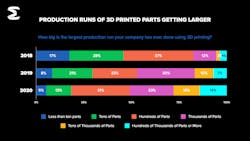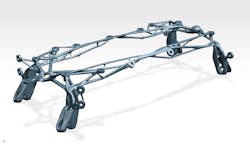Increased Adoption, Acquisitions, and Partnerships Mark 3D Printing’s Advance
3D printing, or additive manufacturing (AM), has been gaining traction in industry for some time now, particularly as it has moved beyond prototyping and into actual production applications.
For instance, many manufacturers have begun using AM to rapidly 3D print spare and replacement parts for onsite equipment to speed repairs, cut costs, reduce unplanned downtime, and save valuable warehouse space by avoiding the need to stock parts in advance. In the automotive and aerospace industries, its chief benefit has been in producing innovative and lightweight components that cannot be achieved via traditional manufacturing techniques—a development that has been a boon as vehicle manufacturers strive to increase fuel economy without compromising the safety or structural integrity of their automobiles and aircrafts.
Perhaps more pertinently, AM has been a vital ingredient in many COVID-19 relief efforts, as manufacturers have raced to produce respirators, face masks, and other personal protective equipment (PPE) at unprecedented speeds. For example, in March 2020, automotive manufacturer Ford teamed up with 3M and GE healthcare to expand their output of PPE, using 3D printing to both rapidly generate respirator designs using components they had on-hand amid supply chain breakdowns as well as to scale production of simpler goods such as face shields.
Growing adoption
“The results of this survey show we’re at the beginning of radical change,” said Blake Teipel, CEO and co-founder at Essentium. “Additive is ready for prime time, and manufacturers are using it to save manufacturing costs while building stronger supply chains that can withstand the worst type of unforeseen events—such as the pandemic.”
Mergers and acquisitions
In addition to the rising adoption rates observed by Essentium, mergers and acquisitions in the AM space signal excitement among some suppliers of AM products and services for further growth to come.
The recently formalized acquisition and merger of Betatype with Oxmet Technologies, which began at the end of 2019, is a prime example. The new corporate entity, called Alloyed, plans to bring together the expertise in advanced process controls and performance previously provided by BetaType with the knowledge of physical metal AM production capabilities specialized in by Oxmet. The company is focused on multi-scale materials and multi-physics modeling, prediction and analysis of thermomechanical fatigue and failure, and the optimization of complex AM processes.
Software partnerships
The software element involved in AM’s growing success cannot be neglected either. Better CAD modeling has improved the ability of end-users to reverse engineer parts, and digital simulations have been invaluable in improving the accuracy and repeatability of various 3D printing applications. Also, cloud computing has allowed databases of parts and components to be digitally stored and shared across space.
Siemens in particular has been a trailblazer in this space, with its previously released AM Path Optimizer and NX CAD convergent modeling software. These software products have seen high growth, not only keeping pace with the 25% annual AM market growth forecasts, but exceeding it over the past three years, according to Siemens.
Following on the success the company has seen here, Siemens recently announced that it plans to partner with Sintavia, Morf3d, and Evolve Additive Solutions to expand its digital portfolio.
Sintavia, a metal additive manufacturer, will work with Siemens to connect all phases of the AM process in an end-to-end manner for optimal efficiency. By driving operations through Siemens software, Sintavia hopes to be able to deliver AM parts more quickly and cost-effectively.
AM machine developer Evolve Additive Solutions, whose technology applies polymers onto rollers to enable high-speed, high-accuracy, and high-volume thermoplastics molding, will equip its machines with Siemens’ AM software to optimize build preparation. This will include part slicing and nesting, global production planning, scheduling, and execution.
Remaining challenges
Although AM is seeing increased use across industry, some challenges remain. For instance, material costs for 3D printing remain high, and issues with quality assurance, low reproducibility, and the need for expensive post-processing steps abound. In addition, a high degree of expertise is necessary to operate 3D printers themselves, with proper material selection and processing vital to ensuring that the parts printed can properly withstand the stresses they will be subjected to. Currently, with few standards in place, AM is still more suited to batches of one than the machine-to-machine variability larger scale production would entail.
However, industry continues to move toward solving these issues. America Makes, a national accelerator for AM managed and operated by the National Center for Defense Manufacturing and Machining is currently engaged in standard-setting and alignment efforts.
Essentium’s survey also highlights these concerns. Even as 84% of respondents felt that companies investing in AM will have a clear competitive advantage in the next five years, 37% noted that further material innovations will be critical to overcoming obstacles facing 3D printing, while 24% felt that unreliable materials were their biggest barrier.


